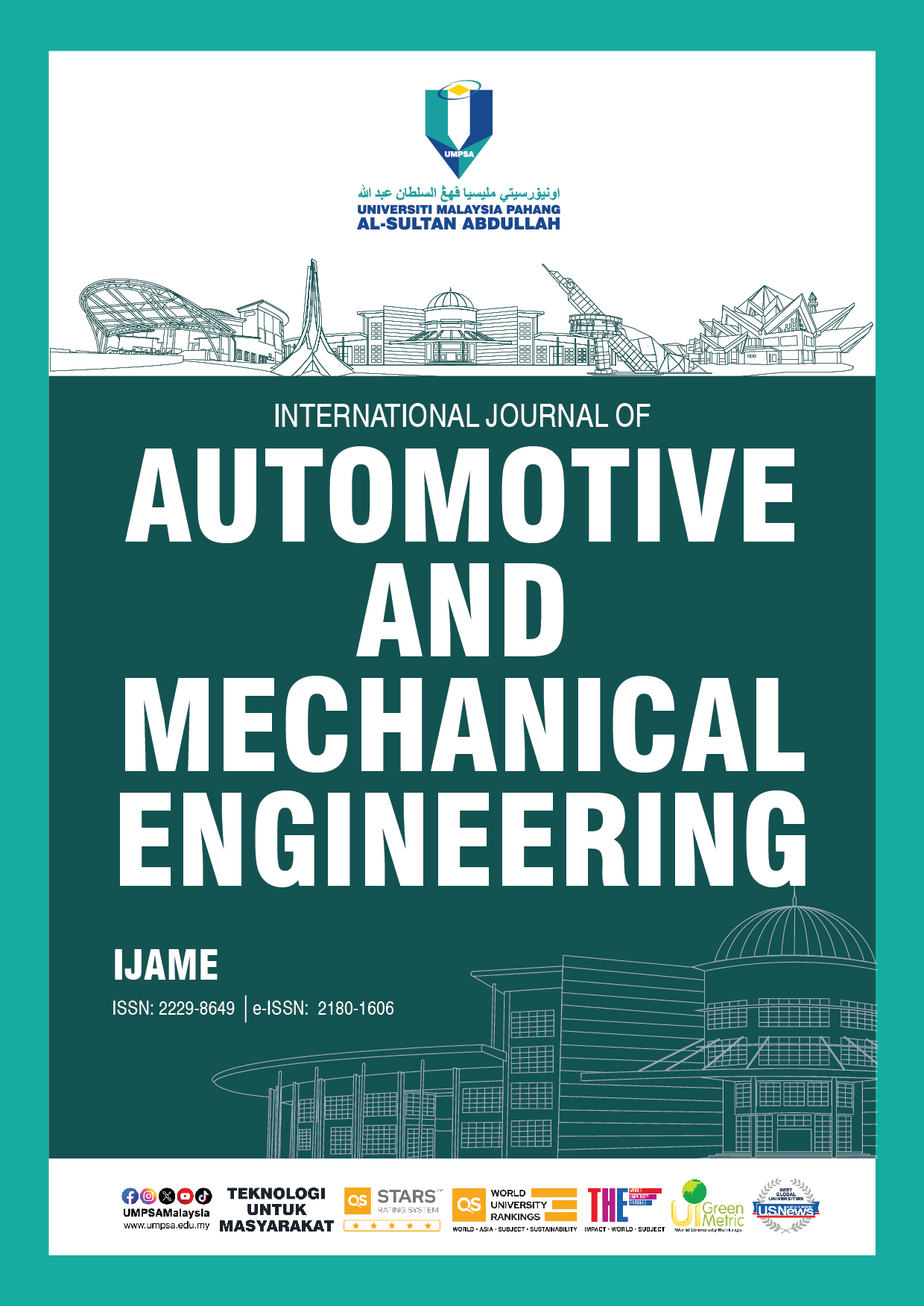Consistency of the Non-Invasive Monitoring Preemie Car Seat (PreeCASE) Device in Assessing Heart Rate, SpO2 Level, and Body Temperature of the Infants
DOI:
https://doi.org/10.15282/ijame.21.3.2024.9.0892Keywords:
Preemie infant, Premature, Vital sign, Consistency, Non-invasive, Car seatAbstract
Advancements in technology have made pulse oximeter devices the preferred choice for parents monitoring their baby's health. However, existing devices present challenges for infants, especially preemies, who need continuous monitoring after being discharged from the hospital. Using conventional baby car seats with wired connections and unstable external vital sign monitors may lead to inaccurate data readings. To resolve this issue, the non-invasive monitoring preemie car seat (PreeCASE) device is well-developed. In this study, we focus on investigating the consistency of the PreeCASE device in assessing the heart rate, SpO2 level, and body temperature of healthy infants. For the methods, ten healthy infants are selected to use the PreeCASE device, and the data is collected and analyzed using standard procedure. The PreeCASE device provides consistent data readings for the three main physiological parameters, heart rate SpO2 level, and body temperature that are displayed on an LCD screen based on the user’s respective levels. The PreeCASE device is precisely designed to facilitate easy and rapid monitoring of infants, especially preemie infants. This innovative device holds significant potential to improve and support pediatricians in effectively caring for infants in Malaysia.
References
W. Tin and M. Lal, “Principles of pulse oximetry and its clinical application in neonatal medicine,” Seminars in Fetal and Neonatal Medicine, vol. 20, no. 3, pp. 192–197, 2015.
S.A. Pullano, I. Mahbub, M.G. Bianco, S. Shamsir, S.K. Islam, M.S. Gaylord et al., “Medical devices for pediatric apnea monitoring and therapy: Past and new trends,” IEEE Reviews in Biomedical Engineering, vol. 10, pp. 199–212, 2017.
S. Beck, D. Wojdyla, L. Say, A.P. Betran, M. Merialdi, J.H. Requejo et al., “The worldwide incidence of preterm birth: A systematic review of maternal mortality and morbidity,” Bulletin of the World Health Organization, vol. 88, no. 1, pp. 31–38, 2010.
J. Beck, M. Reilly, G. Grasselli, H. Qui, A.S. Slutsky, M.S. Dunn et al., “Characterization of neural breathing pattern in spontaneously breathing preterm infants,” Pediatric Research, vol. 70, no. 6, pp. 607-613, 2011.
L. Moschino, S. Zivanovic, C. Hartley, D. Trevisanuto, E. Baraldi, and C.C. Roehr, “Caffeine in preterm infants: Where are we in 2020?” ERJ Open Research, vol. 6, no. 1, 2020.
M. Williamson, R. Poorun, and C. Hartley, “Apnoea of prematurity and neurodevelopmental outcomes: Current understanding and future prospects for research,” Frontiers in Pediatrics, vol. 9, p. 755677, 2021.
C.F. Poets, “Apnea of prematurity: What can observational studies tell us about pathophysiology?” Sleep Medicine, vol. 11, no. 7, pp. 701–707, 2010.
J. Kim, S. Gueye-Ndiaye, E. Mauer, V.K. Modi, J. Perlman, and H. Veler, “Polysomnography use in complex term and preterm infants to facilitate evaluation and management in the neonatal intensive care unit,” Journal of Clinical Sleep Medicine, vol. 17, no. 8, pp. 1653–1663, 2021,
R. Martin, “Neonatal target oxygen levels for preterm infants,” 2019. [Online]. Available: www.uptodate.com
D. Wackernagel, M. Blennow, and A. Hellström, “Accuracy of pulse oximetry in preterm and term infants is insufficient to determine arterial oxygen saturation and tension,” Acta Paediatrica, International Journal of Paediatrics, vol. 109, no. 11, pp. 2251–2257, 2020.
Z. Vesoulis, A. Tims, H. Lodhi, N. Lalos, and H. Whitehead, “Racial discrepancy in pulse oximeter accuracy in preterm infants,” Journal of Perinatology, vol. 42, no. 1, pp. 79–85, 2022.
M.J. Huizing, E. Villamor-Martínez, M. Vento, and E. Villamor, “Pulse oximeter saturation target limits for preterm infants: a survey among European neonatal intensive care units,” European Journal of Pediatrics, vol. 176, no. 1, pp. 51–56, 2017.
R. Sahni, A. Gupta, K. Ohira-Kist, and T. S. Rosen, “Motion resistant pulse oximetry in neonates,” Archives of Disease in Childhood-Fetal and Neonatal Edition, vol. 88, no. 6, pp. F505-F508, 2003.
S. Evanczuk, “Design a Low-Cost Pulse Oximeter Using Off-the-Shelf Components,” 2020. [Online]. Available: https://www.digikey.com/en/articles/design-a-low-cost-pulse-oximeter-using-off-the-shelf-components
I. Nuraresya, U. Nirmal, and P.K. Ng, “A comprehensive review on the development of car booster seats for children,” Current Journal of Applied Science and Technology, vol. 38, no. 1, pp. 1–21, 2019.
H. Rathore, A. Mohamed, A. Al-Ali, X. Du, and M. Guizani, “A review of security challenges, attacks and resolutions for wireless medical devices,” in 2017 13th International Wireless Communications and Mobile Computing Conference, IWCMC 2017, Institute of Electrical and Electronics Engineers Inc., pp. 1495–1501, 2017.
V. Vo, L. Auroy and A. Sarradon-Eck, “Patients’ perceptions of health apps: Meta-ethnographic review of qualitative studies,” JMIR mHealth and uHealth, vol. 7, no. 7, p. e13817, 2019.
P. Brous, M. Janssen, and P. Herder, “The dual effects of the Internet of Things (IoT): A systematic review of the benefits and risks of IoT adoption by organizations,” International Journal of Information Management, vol. 51, p. 101952, 2020.
C. Leung, “Born too soon,” Neuroendocrinology Letters, vol. 25, no. SUPPL. 1, pp. 133–136, 2004.
S.V.G. Subrahmanya, D.K. Shetty, V. Patil, B.M.Z. Hameed, R. Paul, K. Smriti et al., “The role of data science in healthcare advancements: applications, benefits, and future prospects,” Irish Journal of Medical Science, vol. 191, no. 4, pp. 1473–1483, 2022.
J. Kattwinkel, J.M. Perlman, K. Aziz, C. Colby, K. Fairchild, J. Gallagher et al., “Part 15: Neonatal resuscitation: 2010 American Heart Association guidelines for cardiopulmonary resuscitation and emergency cardiovascular care,” Circulation, vol. 122, no. SUPPL. 3, pp. S909-S919, 2010.
M.H.A. Rahim, M.A.H.M. Adib, M.Z. Baharom, I.M. Sahat, and N.H.M. Hasni, “Non-Invasive Study: Monitoring the Heart Rate and SpO2 of the Newborn using InfaWrap Device,” 2020 IEEE-EMBS Conference on Biomedical Engineering and Sciences (IECBES), Langkawi Island, Malaysia, pp. 212-217, 2021.
A.R. Mohd Hanafi, Improving the Infant-Wrap (InfaWrap) device for neonates using the MyI-Wrap mobile application. Springer, Singapore, 2021.
M.H.A. Rahim, M.A.H.M. Adib, M.Z. Baharom, N.H.M. Hasni, “Infant-Wrap (InfaWrap) Device as Pediatric Technology Tool: The Heart Rate and SpO2 Monitoring for Neonates,” in Kuala Lumpur International Conference on Biomedical Engineering, pp. 331-339, 2022.
Downloads
Published
Issue
Section
License
Copyright (c) 2024 The Author(s)

This work is licensed under a Creative Commons Attribution-NonCommercial 4.0 International License.







